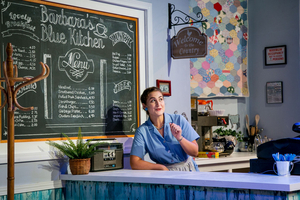Review: BARBARA'S BLUE KITCHEN at Aurora Theatre's Our Stage Onscreen Digital Series
An Experimental Production of Barbara's Blue Kitchen Kicks Off The Our Stage Onscreen Digital Series at Aurora Theatre

Photo by Casey Gardner
News flash: We're in the middle of a pandemic. That means there are no benches and chairs to sit on in your local Barnes & Noble. Baseball patrons are made of cardboard. And the theaters are closed. This last one stings the most, but the best Atlanta theaters are adapting to fill the void left by the absence of live theatre. We've got drive-in cabarets. We've got outdoor opera. And we've got a variety of online stream-from-home offerings, including the new Our Stage Onscreen Digital Series at Aurora Theatre, a series that brings performing arts to homebound season supporters and new audiences while providing a safe workspace for Atlanta theatre artists. The inaugural offering, streaming now through October 4 for a hefty $30 rental fee, is Barbara's Blue Kitchen, a fun - if slightly underbaked - musical with a book, music, and lyrics by Lori Fisher. The small-cast musical works hard to conjure up a slice of homespun Southern life through portraits of workers and customers in a small Southern diner. A brave Chloe Kay, the actor who plays all of the characters in the beautifully rendered diner, likewise, works hard to deliver an engaging evening of for-the-screen theatre, but this first outing is hindered by technical challenges and, regrettably, by the fact that producing theatre specifically for the screen is a tricky tricky business.
The musical tells the story of Barbara Jean, the owner of the small-town diner that serving up more than just their famous Mudslide pie. It's also serving up all of the gossip in the small town of Watertown, Tennessee. We learn that Barbara Jean's on-again-off-again hairstylist boyfriend, Lombardo, beloved if only for the fact that he's been able to cover Barbara Jean's bald spot, is taking another girl on a Bahaman vacation. We learn that little Tommy Lee's stomach hurts on the outside from the 23 stitches he got after his dog, Killer, bit him and that it hurts on the inside from eating almost three hamburgers. And we learn that Miss Tessie's husband died from botulism after eating spinach dip at the Happiness Home retirement community even though he didn't like vegetables.
There's a lot to like about the 2002 musical. Some of the quirky songs like "I Want My Kidney Back" and "Women Aren't Supposed to Go Bald" showcase, as the titles suggest, wonderfully inventive lyrics. That's the greatest strength of the musical. The homespun flavor of the news that travels through the diner is also fun, though, as often happens with Southern comedic dramas, it's peppered with words like "critter" and "ain't" that feel overdone. The book features a radio host, played here by a second actor, who is integrated in an interesting and atmospheric way as he offers up small-town advertisements, jingles, and apologies.
The biggest problem with the musical is that it doesn't manage an actual plot. There are wonderful possibilities, but the musical spreads itself too thin, giving us mostly insignificant portraits of characters that don't feel all that real. And the play doesn't belong to any of the characters. That grows tiresome.
One really bright star in this production is the set design by Jon Sandmaier. Barbara's Blue Kitchen, as rendered here, is a place where people go to find comfort. A gorgeous menu board boasts Southern entrees, including something called a "Garbage Platter." Charming ruffled gingham tablecloths cover the diner's tables. A homemade quilt that hangs on one wall is surely an impressive tribute to somebody's dead grandmother. And, of course, the Mudslide pie waits on the counter. Every detail works to create the perfect place to spend a little time in.
The weakness with this creative and experimental production is that it's shot in segments to create the sense that Barbara Jean and the others in the diner are actually there together. In the theater, we would, of course, be watching one actor as she plays all of the parts in a continuous production. The concept here is creative, but it simply doesn't translate well from the stage to the screen as edited. In addition to the problems with the adaptation, the continuity of the scenes is not as strong as it could be. As the camera switches between characters, the point of focus for the actor is often just a little bit off, as is the perspective. Even the slightest errors here create significant distraction.
While this first outing for the Our Stage Onscreen Digital Series deserves the grandest praise for creating a space for theatre artists to safely work in and a platform for audiences at home to see those theatre artists at work, they haven't quite yet figured out what this series is going to be. I hope the series moves in a direction that is a little less experimental and that aligns with the name of the series. I want to see the Aurora stage onscreen. That's not exactly what we got here. But, much like those benches and chairs at Barnes & Noble, it's definitely something we miss.
Reader Reviews
Videos

